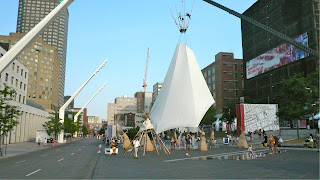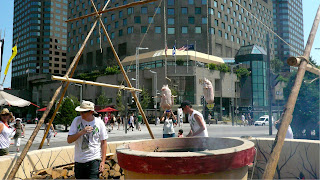Adrien Welsh
Can the Canadian state really call itself a positive example when it comes to the national question and self-determination?
 Just talking about the situation of the First People, there’s a lot to say. For example, the Harper Conservative government waited until 2010 to simply consent to sign the Declaration on the Rights of Indigenous Peoples -- almost three years after it was adopted by the UN’s General Assembly. And First People’s communities are still subject to an obsolete law, The Indian Act, which was used as a model by the South African Afrikaner’s ruling class to inspire the apartheid regime!
Just talking about the situation of the First People, there’s a lot to say. For example, the Harper Conservative government waited until 2010 to simply consent to sign the Declaration on the Rights of Indigenous Peoples -- almost three years after it was adopted by the UN’s General Assembly. And First People’s communities are still subject to an obsolete law, The Indian Act, which was used as a model by the South African Afrikaner’s ruling class to inspire the apartheid regime!These facts are generally not mentioned, even in Canadian school history textbooks -- which, of course, does not help resolve the tense situation that Aboriginal People experience. Here in Québec, these tensions reached a climax in 1990 with the "Oka Crisis," during which a lot of racist prejudices were expressed against Kanesatake Mohawks because they stood up against policies of genocide and assimilation and to defend their traditional territories.
In reaction to the racism at Oka, Innu cinematographer André Dudemaine helped create the Montreal First People’s Festival in 1991. The event has kept growing ever since. Today it acts as an important forum for the promotion and better understanding of First Nations’ culture, as well as a place where Montreal’s public can learn more about the struggles and challenges of Indigenious Peoples all around the world.
This year, the First People’s Festival celebrated its 22nd edition which took place from July 31st to August 8th. More than 50 films were screened (including documentaries, short footage and long footage, motion pictures as well as animation movies) for the modest sum of 2$ per screening!
The struggle for language
The importance of language-related films has to be underlined as one of the major themes of the movies screened. Two documentaries featuring Noam Chomsky were show as well as the first movie (an animation) in the Mohawk language ever produced. The animation explains in a funny tone why, in Iroquoian tradition, beans, corn and squash are called the «three sisters», and why they grow together.
Viewers also had a chance to hear the Pirahã language, spoken by the Hyponym indigenious people from Brazil (the language that, according to Dan Everette who deeply studied Pirahã, presents some features contradicting Chomsky’s theory of recursivity, which until now had been considered the central paradigm of modern linguistics).
Another documentary told the story of the outstanding work achieved by Jessie Little Doe Baird since 1993. Baird helped revive the Algonquian Wampanoag language among her community, a language that was almost dead. Both Dan Everett and Jessie Little Doe Baird attended the festival, discussing their work openly with festival goers.
 The importance of language for First People is not accidental. Language is one of the main characteristics describing a nation. Language evolves along with the awakening of national consciousness, and against national and linguistic oppression. After all, the case of Wampanoag is not isolated. The same is true for Huron-Wendat or Abenakis, languages which tragically count less than ten fluent speakers right now.
The importance of language for First People is not accidental. Language is one of the main characteristics describing a nation. Language evolves along with the awakening of national consciousness, and against national and linguistic oppression. After all, the case of Wampanoag is not isolated. The same is true for Huron-Wendat or Abenakis, languages which tragically count less than ten fluent speakers right now.Reintegrating languages in all spheres of society, including cinema or just everyday life, shows us how determined Aboriginal peoples are to rectify the national and linguistic oppression they have suffered.
Untold stories
Many of the documentaries screened this year were highly social or political in concern. In Smoke Traders, by Jeff Dorn, the question of the cigarette "business" in Mohawk territories is presented from a Native point of view. The audience comes to understand how this trade, perceived as contraband, is actually an economic backbone of life on impoverished reserves.
In her film Granito: How to Nail a Dictator Pamela Yates (winner of the Festival’s Rigoberta Menchú award) performs a flash-back on the Guatemalan civil war and especially on her well known documentary When the Mountains Tremble. According to a Spanish lawyer trying to accuse former General Efraín Rios Montt for this genocide of 20 000 Mayan people, Yates' footage may contain information that could help charge those responsible.
More than just films
While cinematography used to be the Festival's principal aim, today it has a multi-disciplinarity approach, including literature (people could attend readings by Native poets or writers), as well as music, dance and craft work. Probably one of the most notable achievements made by the Festival team is the outdoor site at Montreal’s Place des festivals.
For a weekend the space is covered by native craftspeople, tipis, and much more. Despite being in downtown Montreal, festival goers could enjoy the smell of pine trees and goose cooked on an open fire, and talk with all the attending craftspeople giving workshops about their work, usually strongly linked to their culture. As well, every day different outstanding performances were held in the area, including Florent Vollant, an Innu from Northern Québec and an electro music show by the group A Tribe Called Red, a collaboration with Berber musicians from Morocco.

One of the highlights of the Festival is the traditional «Boréades de la danse», a dance performance by troops representing nations from all over the Americas. This year, it was followed by the Nuestro América Friendship Parade, which for the first time saw participation of delegations representing Bulgaria and the Philipines. The parade ended at Place des festivals, they were welcomed by the Mohawk drum troop Keepers of the Eastern Door before a talk in French, Spanish, English and Bulgarian about the UN’s Charter for Indigenous Rights.
A national awakening
While the First People’s Festival can be a little too folkloric, it is one of the very few large events in Québec, and Canada, prioritizing a truly broad perspective on First People’s culture and struggles all around the world. It challenges festival goers to try to understanding the problematics First People's face on a daily basis. The Festival is also a place to build bridges between different cultures, and to try counteract the many prejudices that First Nations people combat.
The fact that there is more than enough material to organize such an event - which, as said previously, keeps growing since its first edition - is a testimony of the important national awakening among Aboriginal People. This is something that progressive people should fully support. Afterall, the rights of First Peoples inseparably goes together with respecting and defending their culture and language, milestones on which any nation is built.
Adrien Welsh is a student and activist in Montreal and has worked at the First People's Festival for several years.









No comments:
Post a Comment